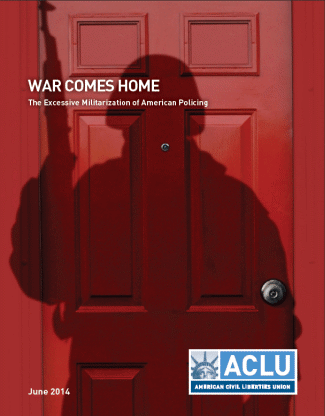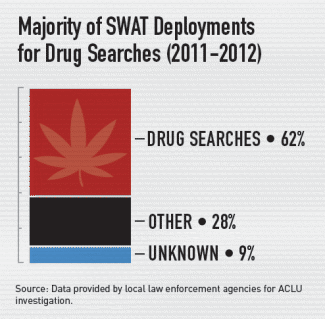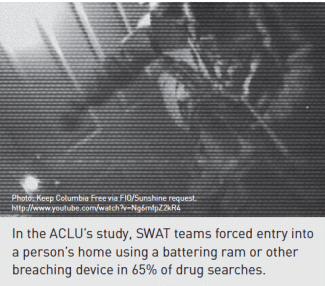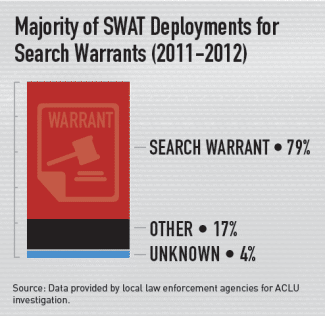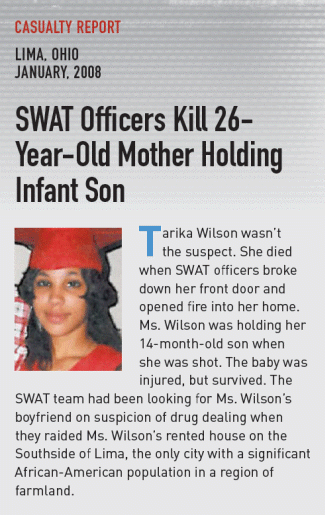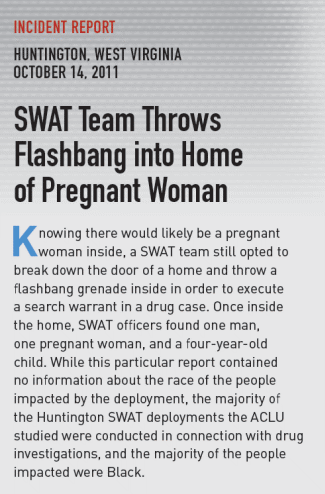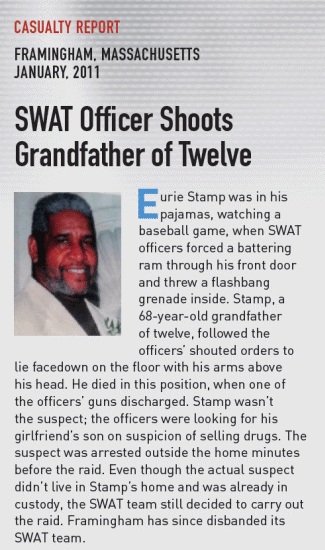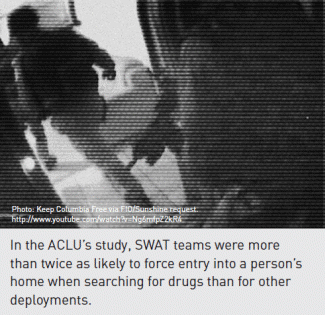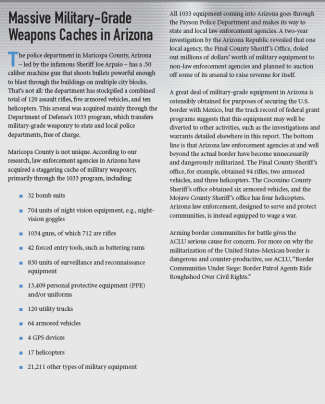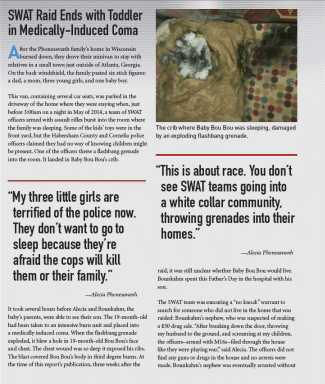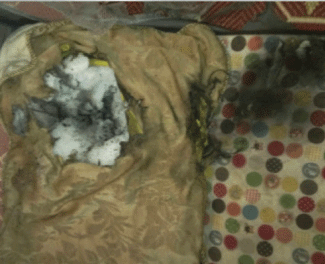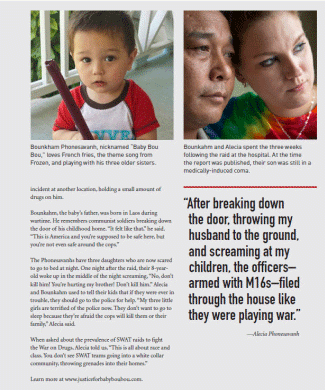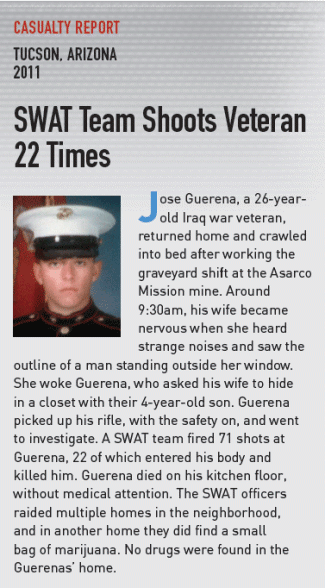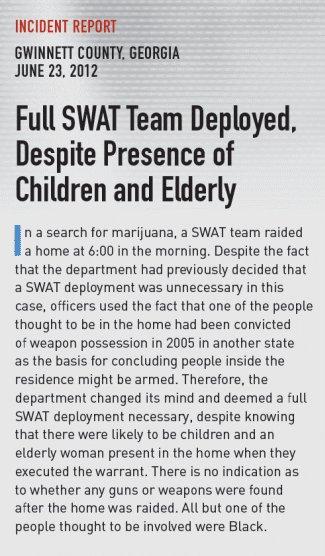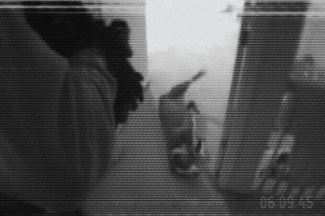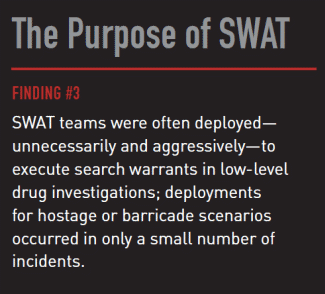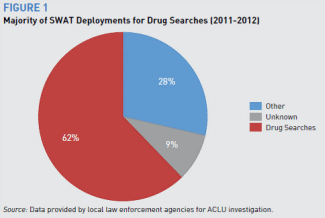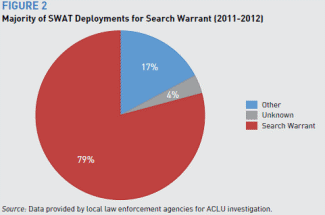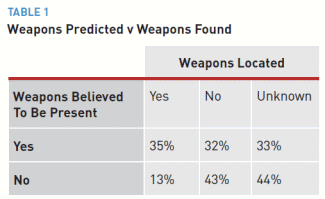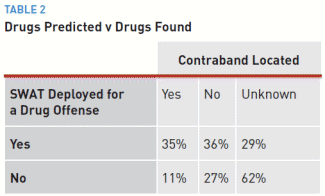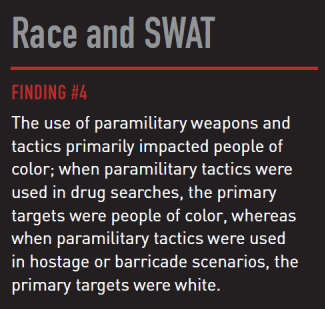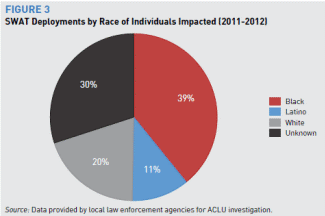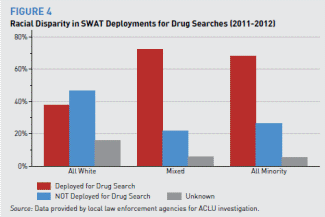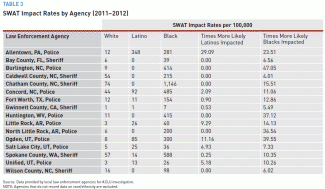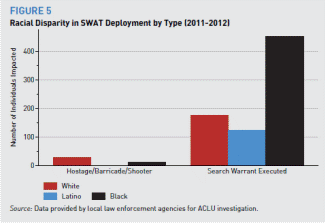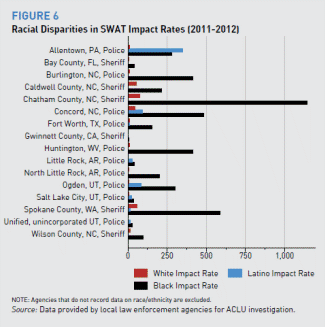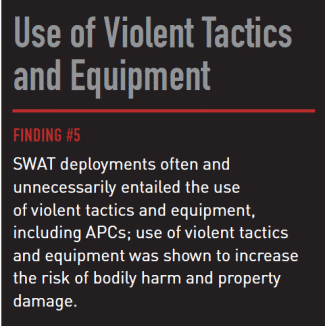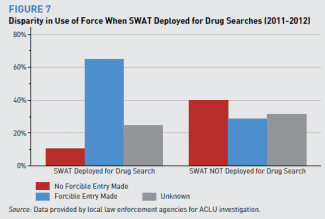PART 1 OF 2
DISCUSSIONS AND FINDINGS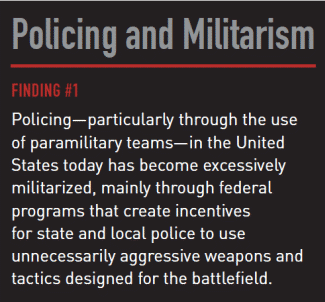 Policing and Militarism
Policing and MilitarismFINDING #1
Policing—particularly through the use of paramilitary teams—in the United States today has become excessively militarized, mainly through federal programs that create incentives for state and local police to use unnecessarily aggressive weapons and tactics designed for the battlefield.
Use of Military Equipment by SWAT TeamsIt is clear from this investigation and other research [40] that American policing has become excessively militarized. We can see this in the use of military-style equipment— weapons and tactics designed for the battlefield—to conduct ordinary law enforcement activities. Police officers use these weapons routinely, across the United States, to force their way into the people’s homes, disrupting lives and destroying communities.
One such weapon is the battering ram—“a large and heavy piece of wood or other material that is used to hit and break through walls and doors” [41]—which is nearly always carried on deployments, and the primary tool used to breach doors and windows (though explosive breaching— the use of explosives to cut through doors—seems to be gaining popularity).
Another device often used by SWAT teams is the flashbang grenade (sometimes referred to generically as a “distraction device”), an explosive device that is used to distract the occupants of a building while a SWAT team is attempting to secure the scene. [42] Flashbang grenades produce an extremely bright flash of light that temporarily overstimulates the retina and causes temporary blindness (lasting 5 to 10 seconds). They also make a deafening noise that makes people feel disoriented and can cause a lingering ringing. Although they are generally considered to be nonlethal, they have been known to set homes on fire [43] and induce heart attacks, [44] both sometimes resulting in death. In 2010, 7-year-old Aiyana Stanley-Jones was killed when, just after midnight, a SWAT team threw a flashbang grenade through the window into the living room where she was asleep. The flashbang burned her blanket and a member of the SWAT team burst into the house, firing a single shot, which killed her. [45]
 Aiyana Stanley-Jones
Aiyana Stanley-JonesBoth battering rams and flashbang grenades can cause extensive property damage—half of the incidents the ACLU reviewed involved property damage such as damage to doors and/or windows (in another 30 percent of cases, it was impossible to know whether there was property damage in connection with a SWAT deployment, so the total may be higher). SWAT incident reports almost never included an estimate of the amount of damage, and none of the incident reports reviewed suggested that the owners or residents of a home damaged by use of a battering ram or flashbang grenade would be reimbursed for repairs.
When SWAT teams deploy, they typically wear combat helmets and “battle dress uniforms” (BDUs), fatigues designed for use by the U.S. Army throughout the 1980s and 1990s. The ACLU documented a total of 15,054 battle uniforms or other personal protective equipment received by 63 responding agencies during the relevant time period. The use of BDUs is another trend in the militarization of policing; as retired police officer Bill Donelly stated in a letter to the editor in the Washington Post, “One tends to throw caution to the wind when wearing ‘commando-chic’ regalia, a bulletproof vest with the word ‘POLICE’ emblazoned on both sides, and when one is armed with high tech weaponry…Police agencies face tactical challenges that do require a specialized and technically proficient team approach, but fortunately these incidents are relatively infrequent even in the largest cities. It would appear that U.S. law enforcement, even in the smallest and safest communities, is suffering from a collective ‘inferiority complex’ that can be relieved only by military-style clothing and arsenals of formidable firepower.” [46]
Another piece of equipment that seems to be gaining popularity among SWAT teams is the armored personnel carrier (APC). APCs were created to transport infantry and provide protection from shrapnel and small arms fire on the battlefield. One version popular with law enforcement agencies is the Ballistic Engineered Armored Response Counter Attack (BearCat) APC, but more modern APCs include the MRAP (Mine Resistant Ambush Protected) vehicle, which provides additional protection from improvised explosive devices (IEDs). In the battlefield, APCs are typically armed with machine guns mounted on top of the vehicle in a turret; when used domestically, the guns are removed and the vehicle is used primarily for protection by law enforcement responding to SWAT call-outs and emergencies. Thus, APCs are not typically armed when in use by domestic law enforcement; however, they appear threatening and observers do not necessarily have reason to know whether an APC is armed.
In 2013, the Department of Defense started giving away MRAPs through the 1033 Program. According to the Department of Defense, MRAPs are designed to protect occupants against armor-piercing roadside bombs. [47] In 2007, the United States spent $50 billion to produce 27,000 MRAPs and deploy them to Iraq and Afghanistan. [48] No longer needed overseas, MRAPs have made their way into local communities. Because the ACLU launched this investigation in early 2013 and requested records only from 2011-2012, we did not ask the jurisdictions studied to send documentation of MRAP requests, so it is not possible to know from this investigation how many towns have acquired such vehicles through the 1033 Program. Media accounts put the number at around 500. [49] Dallas, Texas, has one. [50] So does Salinas, California, [51] as well as the Utah Highway Patrol. [52] And, perhaps most bizarrely, the Ohio State University Police has one—in order to provide “presence” on football game days. [53]
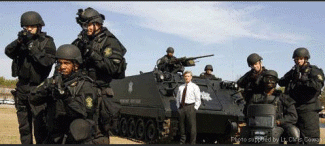 Police in South Carolina pose with their BearcatMilitary Training
Police in South Carolina pose with their BearcatMilitary TrainingThe militarization of policing culture is also apparent in the training that tactical teams receive—SWAT team members are trained to think like soldiers. The ACLU asked hundreds of law enforcement agencies to submit copies of SWAT training materials. One response from the Farmington, Missouri, Special Response Team consisted of a piece written by Senior Police-One Contributor Chuck Remsberg for Killology Research Group. The piece summarizes a presentation given at a conference of the International Association of Law Enforcement Firearms Instructors and warns that “preparations for attacks on American schools that will bring rivers of blood and staggering body counts are well underway in Islamic terrorist camps.” It further states that “police agencies aren’t used to this…We deal with acts of a criminal nature. This is an act of war, but because of our laws we can’t depend on the military to help us…[T]he U.S. in [sic] the one nation in the world where the military is not the first line of defense against domestic terrorist attack. By law, you the police officer are our Delta Force.” It provides “‘4 Ds’ for Thwarting Terrorists’ Plans to Massacre Our School Children” and concludes with an admonition to “Build the right mind-set in your troops.” [54]
Even if there were merit to the argument that training SWAT teams to think like soldiers in the context of a school shooting would provide them with the skills that they need to respond effectively, it appears that training in how to develop a “warrior” mentality is pervasive and extends well beyond hostage situations and school shootings, seeping into officers’ everyday interactions with their communities. For example, the Cary, North Carolina, SWAT team provides a training session explicitly titled “Warrior Mindset/Chemical Munitions” for all Emergency Response Team personnel. A PowerPoint training presentation sent by the National Tactical Officers Association urges trainees to “Steel Your Battlemind” and defines “battlemind” as “a warrior’s inner strength to face fear and adversity during combat with courage. It is the will to persevere and win. It is resilience.” Neither of these training documents suggests that SWAT teams should constrain their soldier-like tactics to terrorism situations. Additionally, in the documents reviewed for this report, the majority of SWAT raids took place in the context of serving search warrants at people’s homes—not in response to school shootings or bombings.
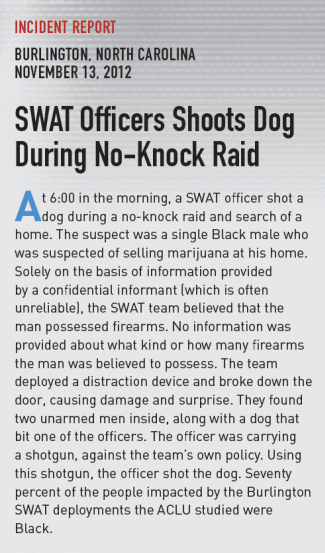
INCIDENT REPORT BURLINGTON, NORTH CAROLINA NOVEMBER 13, 2012
SWAT Officers Shoots Dog During No-Knock Raid
At 6:00 in the morning, a SWAT officer shot a dog during a no-knock raid and search of a home. The suspect was a single Black male who was suspected of selling marijuana at his home. Solely on the basis of information provided by a confidential informant (which is often unreliable), the SWAT team believed that the man possessed firearms. No information was provided about what kind or how many firearms the man was believed to possess. The team deployed a distraction device and broke down the door, causing damage and surprise. They found two unarmed men inside, along with a dog that bit one of the officers. The officer was carrying a shotgun, against the team’s own policy. Using this shotgun, the officer shot the dog. Seventy percent of the people impacted by the Burlington SWAT deployments the ACLU studied were Black.
Training programs like these impact how some SWAT officers view the people in their communities. For example, in one of the cases examined for this report, a SWAT team drove a BearCat APC into a neighborhood for the sole purpose of executing a warrant to search for drugs. Once the SWAT officers arrived at the home, they drove the APC to the residence, broke down the front and back doors, destroyed a glass table, deployed a distraction device, and pried a lock off a shed, all to find the house empty. One of the officers noted in his report that the house was “empty of suspects and civilians.” The distinction between “suspects” and “civilians” is telling. If police see suspects less as civilians and more as enemies, what effect does that have on police-suspect interactions?
Legality of Forced Entry Into People’s HomesGenerally speaking, the Fourth Amendment to the U.S. Constitution prohibits the police from entering a person’s home without a warrant. Historically, if the police had a warrant to search a person’s home, they were required by law to knock on the door, announce their presence, and wait for someone to answer. [55] When a person answered the door, the police were required to show the warrant and were then entitled to demand entry to conduct a search.
Although the “knock-and-announce” rule still exists, today police executing a search warrant need not follow the rule if they have “reasonable suspicion” that the circumstances present a threat of physical violence or that evidence would be destroyed if advance notice were given. [56] Further, if they believe in advance of executing the search warrant that either of these circumstances will exist, they can obtain a “no-knock warrant,” which allows them to enter a person’s home without knocking. In either case, the police are permitted to force their way into a person’s home. As a consequence, even though the police are not allowed to barge their way into a person’s home simply because they believe drugs are present, [57] given that any time they have reasonable suspicion that knocking and announcing their presence would “inhibit the investigation of the crime by … allowing the destruction of evidence,” [58] the reality is that drug cases often provide police with vast discretion to use forced entry into a person’s home to execute a search warrant. Even when a court finds that the police have violated the knock-and-announce rule, the Supreme Court has held that the prosecution can still use the evidence seized as a result of a subsequent search at trial, significantly diluting the knock-and-announce requirement’s value as a deterrent to police overreach. [59]
While search warrants authorize the police to search a given place for a particular item or items, they rarely delineate the tactics the police may use in executing the warrant (other than no-knock warrants, which, as explained above, authorize the police to enter without knocking or announcing their presence, and sometimes specifically authorize use of a night-time search). And though the Supreme Court has held as a general matter that the method of police entry into a home is a factor to be considered in assessing the reasonableness (and, hence, constitutionality) of the search, [60] there is no per se prohibition on the use of any particular method. Therefore, the fact that the police obtained a warrant in a given case does little to constrain their broad discretion to decide whether to deploy a SWAT team, break down a door with a battering ram, deploy a distraction device, etc.
In sum, while courts can at times provide recourse to violations of Fourth Amendment rights, by and large they do not offer robust protection from police use of aggressive equipment and tactics to execute search warrants in people’s homes.
Federal Incentives to Militarize PolicingThe Department of Defense operates the 1033 Program through the Defense Logistics Agency’s (DLA) Law Enforcement Support Office (LESO), whose motto is “from warfighter to crimefighter.” According to LESO, the program has transferred $4.3 billion worth of property through the 1033 Program. [61] Today, the 1033 Program includes more than 17,000 federal and state law enforcement agencies from all U.S. states and territories. The amount of military equipment being used by local and state police agencies has increased dramatically—the value of property transferred though the program went from $1 million in 1990 to $324 million in 1995 and to nearly $450 million in 2013. [62]
The 1033 statute authorizes the Department of Defense to transfer property that is “excess to the needs of the Department,” [63] which can include new equipment; in fact, 36 percent of the property transferred pursuant the program is brand new. [64] Thus, it appears that DLA can simply purchase property from an equipment or weapons manufacturer and transfer it to a local law enforcement agency free of charge. Given that more than a third of property transferred under the program is in fact new, it appears that this practice happens with some regularity.
 LAW ENFORCEMENT SUPPORT OFFICE: FROM WARFIGHTER TO CRIMEFIGHTER
LAW ENFORCEMENT SUPPORT OFFICE: FROM WARFIGHTER TO CRIMEFIGHTERA statistical analysis of the transfer of equipment under the 1033 Program is beyond the scope of this report, but we uncovered numerous examples of transfers that give cause for concern. For example, during the years covered by the investigation, the North Little Rock, Arkansas, police obtained at least 34 automatic and semi-automatic rifles, two MARCbots (robots designed for use in Afghanistan that are capable of being armed), several ground troop helmets, and a Mamba tactical vehicle. [65] The Arkansas state coordinator found that the LESO application for participation and the state memorandum of agreement were outdated, in addition to many weapons being unaccounted for in the inventory. Despite this, the coordinator signed off on a form that said all the inventory forms were accurate. Bay County, Florida, received several military-style rifles, a forklift, and several utility trucks. The same county also has on inventory numerous M-16s, M-14s, sniper rifles, submachine guns, and ballistic shields, though it is not clear from the records whether Bay County obtained those items through the 1033 Program, from another federal source, or otherwise. Gwinnett County, Georgia, received nearly 60 military-style rifles, as well as numerous combat vests and Kevlar helmets.
In addition, agencies are permitted to transfer equipment obtained through the 1033 Program between each other. The ACLU uncovered numerous examples of state and local law enforcement agencies transferring equipment that they had obtained through the 1033 Program. There do not appear to be any limitations on or oversight of this practice.
As the saying goes, if all you have is a hammer, everything looks like a nail. [66] Likewise, if the federal government gives the police a huge cache of military-style weaponry, they are highly likely to use it, even if they do not really need to. Gwinnett County, Georgia, for example, received at least 57 semi-automatic rifles, mostly M-16s and M-14s, through the 1033 Program during the relevant time period. A third of Gwinnett County’s SWAT deployments were for drug investigations; in half of them, the SWAT team broke down the door to get inside, and there was no record in any of the reports that weapons were found. In several of these cases, damage resulted to people’s homes; in one case, the SWAT team deployed tear gas into a home in order to serve an arrest warrant, knowing there were people inside who were not subjects of the warrant. It is not possible to prove definitively that the weapons procured through the 1033 Program incentivized these deployments in Gwinnett. However, it is reasonable to infer that the program—the very purpose of which is to equip local police officers to use military equipment in drug investigations—has increased the likelihood that local police departments, not just in Gwinnett County but across the country, will deploy military weapons and tactics in drug investigations when possible.
“Our application talked about the danger of domestic terrorism, but that’s just something you put in the grant application to get the money. What red-blooded American cop isn’t going to be excited about getting a toy like this? That’s what it comes down to.” —Keene, N.H. City Councilmember
Mission CreepIt is clear that local law enforcement agencies use DHS funds ostensibly obtained for the purpose of fighting terrorism to conduct ordinary law enforcement activities. In New Hampshire, for example, three police departments—in Concord, Keene, and Manchester (cities that are separated from each other by approximately 30 miles)—each used DHS grants to fund the purchase of an armored BearCat (the amount of grants received by these agencies ranged from $215,000 to $286,000). Justifications offered for these grants included prevention, protection, response, and recovery activities pertaining to weapons of mass destruction and the threat of terrorism. The Keene, New Hampshire, police department, for example, stated in its application for DHS grant funding to purchase an APC that “[t]he terrorism threat is far reaching and often unforeseen. Terrorist’s [sic] goals, regardless of affiliation, usually encompass the creation of fear among the public, convincing the public that their Government is powerless to stop the terrorists, and get immediate publicity for their cause.” The application goes on to cite Keene’s annual pumpkin festival as a potential terrorism target in need of protection with an APC. [67]
Not even Keene city officials believed that the city actually needed the BearCat to thwart terrorism. To explain why the police included the word “terrorism” on their application for federal funding for this purchase, a city councilmember said, “Our application talked about the danger of domestic terrorism, but that’s just something you put in the grant application to get the money. What red-blooded American cop isn’t going to be excited about getting a toy like this? That’s what it comes down to.” [68]
The police chief in San Diego, California, expressed the same sentiment when asked about his agency’s decision to purchase an armored personnel carrier: “‘If we had to take on a terrorist group, we could do that,’ said William Lansdowne, the police chief in San Diego and a member of the board of the Major Cities Chiefs Association. Though his force used federal grants to buy one of those fancy armored vehicles—complete with automatic-gun portals— he said the apparatus was more useful for traditional crime-busting than counter-terrorism.” [69]
It is equally clear that the DOJ’s Byrne JAG funding is being used to conduct unnecessarily aggressive activities in drug cases. Approximately 21 percent of all law enforcement JAG funds go to task forces, the majority of which are drug task forces, which routinely employ paramilitary tactics in drug investigations. [70] Byrne JAG drug task forces have been widely criticized for incentivizing unnecessarily aggressive, often militarized, tactics—particularly in communities of color. [71] As of 2011, 585 multi-jurisdictional task forces were funded through the JAG program. [72] JAG funds often support drug task forces by paying for the salaries or overtime hours of task force officers as well as for vehicles and equipment; in 2012-2013, more than 680,000 law enforcement overtime hours were paid for using JAG funds. [73]
According to documents uncovered by the ACLU, local law enforcement agencies often received substantial funding from the DHS and DOJ during the time period studied. The city of Austin, Texas, for example, received $2.2 million in federal grant funding from August 2010 through January 2012. Fort Worth, Texas, received $1.2 million in 2011 and 2012 combined. Similarly, since August 2013, the Salt Lake City Police Department has received almost $2 million in federal grant awards. However, awards are not limited to large cities. In Montana, the Helena Police Department received $733,000 in DHS grants, and the Montana Department of Justice received more than $1 million in DHS grants. Likewise, Gastonia, North Carolina, has received more than $180,000 in federal funding since 2009, while the Bay County, Florida, Sheriff’s Department has received approximately $360,000 in federal funding since late 2011. In 2011, the Raleigh Police Department received $120,000 as part of the 2011 State Homeland Security Program.
A 2004 classified memo all but confirms the blurring of the lines between the drug war and the U.S. military by calling the Drug Enforcement Agency (DEA) The “Other” Warfighter and stating that the War on Drugs “has all the risks, excitement, and dangers of conventional warfare. [74]
Simply put, American policing has become excessively militarized.
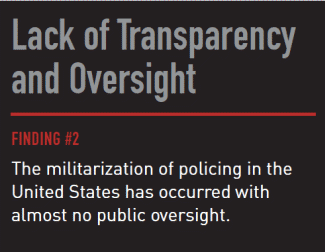 Lack of Transparency and Oversight
Lack of Transparency and OversightFINDING #2
The militarization of policing in the United States has occurred with almost no public oversight.
Limitations of Data Collection on SWAT UseData concerning the prevalence of SWAT is difficult to collect. [75] The ACLU filed public records requests with more than 255 law enforcement agencies during the course of this investigation. One hundred and fourteen of the agencies denied the ACLU’s request, either in full or in part. Even if the ACLU had received and examined responsive documents from all 255 law enforcement agencies that received public records requests, this would represent only a sliver of the more than 17,000 law enforcement agencies that exist throughout the United States, and thus would shine only a dim light on the extent of police militarization throughout the country.
The agencies that refused to comply with our requests offered various justifications for the refusals, including the following:
• The requested documents contained trade secrets.
• Concerns about jeopardizing law enforcement effectiveness.
• The requested documents did not constitute “public records.”
• The request was “overbroad and voluminous.”
• The costs associated with producing the documents were simply prohibitive.
It strains credibility to believe that the information contained in SWAT incident reports contains “trade secrets.” A trade secret is a commercially valuable plan, formula, process, or device. It is “a secret, commercially valuable plan, formula, process, or device that is used for the making, preparing, compounding, or processing of trade commodities and that can be said to be the end product of either innovation or substantial effort.” [76] A police report is not a “commercially valuable plan.” Furthermore, most law enforcement agencies contacted did in fact provide some records, belying the notion that the records requested did not constitute “public records,” that there were legitimate concerns about law enforcement effectiveness, or that the request was “overbroad and voluminous.” These are simply excuses to avoid complying with the ACLU’s request. In fact, the public should not even have to resort to public records requests to obtain information about policing practices—this information should be readily available.
Data collecting and reporting in the context of SWAT was at best sporadic and at worst virtually nonexistent
The records that were produced revealed an extremely troubling trend: that data collecting and reporting in the context of SWAT was at best sporadic and at worst virtually nonexistent. Not a single law enforcement agency in this investigation provided records containing all of the information that the ACLU believes is necessary to undertake a thorough examination of police militarization. Some agencies (e.g., Tupelo, Mississippi) provided records that were nearly totally lacking in important information. Others (e.g., Salt Lake City, Utah) provided records that were quite lengthy, though still incomplete and extremely difficult to analyze because of their lack of organization. Others (e.g., Fort Worth, Texas) provide fairly comprehensive information, though often in narrative form, making statistical analysis difficult. This variation has two immediate results: (1) any analysis of the data will necessarily have to contend with a large number of unknowns (as demonstrated above) and (2) it makes systematic, thorough, and uniform collection of SWAT data, at any level of government, impossible.
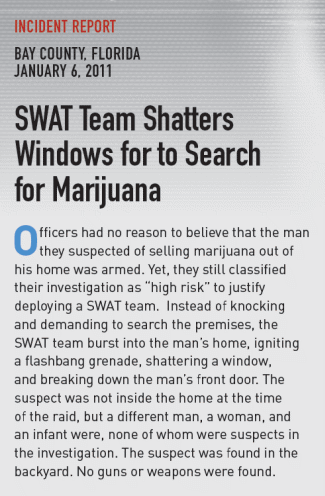
INCIDENT REPORT BAY COUNTY, FLORIDA JANUARY 6, 2011
SWAT Team Shatters Windows to Search for Marijuana
Officers had no reason to believe that the man they suspected of selling marijuana out of his home was armed. Yet, they still classified their investigation as “high risk” to justify deploying a SWAT team. Instead of knocking and demanding to search the premises, the SWAT team burst into the man’s home, igniting a flashbang grenade, shattering a window, and breaking down the man’s front door. The suspect was not inside the home at the time of the raid, but a different man, a woman, and an infant were, none of whom were suspects in the investigation. The suspect was found in the backyard. No guns or weapons were found.
Lack of State and Local OversightThere is almost no oversight of SWAT at the state or local level. Maryland is the exception—in 2009, Maryland enacted a law requiring law enforcement agencies that maintain a SWAT team to report, semi-annually, specific activation and deployment information. [77] The law required the Police Training Commission, in consultation with the Governor’s Office of Crime Control and Prevention, to develop a standardized format for each agency to use in reporting data. [78] It also provided that if a law enforcement agency failed to comply with the reporting provisions, the fact of noncompliance by that particular agency would be reported to the state legislature. [79] Utah enacted a similar bill this year. [80]
Police Raid Berwyn Heights Mayor's Home, Kill His 2 DogsBy Aaron C. Davis
Washington Post Staff Writer
Thursday, July 31, 2008

 Mayor Cheye Calvo, right, and his wife Trinity Tomsic in Berwyn Heights in 2006. (Lois Raimondo - Post)
Mayor Cheye Calvo, right, and his wife Trinity Tomsic in Berwyn Heights in 2006. (Lois Raimondo - Post)A police SWAT team raided the home of the mayor in the Prince George's County town of Berwyn Heights on Tuesday, shooting and killing his two dogs, after he brought in a 32-pound package of marijuana that had been delivered to his doorstep, police said.
Mayor Cheye Calvo was not arrested in the raid, which was carried out about 7 p.m. by the Sheriff's Office SWAT team and county police narcotics officers. Prince George's police spokesman Henry Tippett said yesterday that all the residents of the house -- Calvo, his wife and his mother-in-law -- are "persons of interest" in the case.
The package was addressed to Calvo's wife, Trinity Tomsic, said law enforcement officials, who spoke on condition of anonymity because the case is ongoing.
Tippett said police are working to determine for whom the drugs were meant.
Calvo said yesterday that he did not know how the drugs wound up on his doorstep. He works part time as the mayor and serves as director of expansion for the SEED Foundation, a well-known national nonprofit group that runs urban public boarding schools.
"My government blew through my doors and killed my dogs," Calvo said. "They thought we were drug dealers, and we were treated as such. I don't think they really ever considered that we weren't."
Calvo described a chaotic scene, in which he -- wearing only underwear and socks -- and his mother-in-law were handcuffed and interrogated for hours. They were surrounded by the dogs' carcasses and pools of the dogs' blood, Calvo said.
Spokesmen for the Sheriff's Office and Prince George's police expressed regret yesterday that the mayor's dogs were killed. But they defended the way the raid was carried out, saying it was proper for a case involving such a large amount of drugs.
Sgt. Mario Ellis, a Sheriff's Office spokesman, said the deputies who entered Calvo's home "apparently felt threatened" by the dogs.
"We're not in the habit of going to homes and shooting peoples' dogs," Ellis said. "If we were, there would be a lot more dead dogs around the county."
Calvo, 37, has been mayor of the 3,000-person town near College Park since 2004. His wife is a finance officer for the state, he said.
The investigation that led police to their house in the 8500 block of Edmonston Road began in Arizona, officials said. There, a police dog at a shipping facility identified the package as being filled with marijuana. Prince George's officers posed as deliverymen and brought it to Calvo's home.
Calvo said he came home early from work Tuesday. While walking the dogs, Calvo said, he noticed several black sport-utility vehicles and a woman parked in a car down the street.
"I figured someone was having a party," he recalled.
It was the police. They were watching, waiting for someone to bring the package into the house.
As Calvo returned to the house, he said, he spotted the large package that his mother-in-law had told a deliveryman to leave on the porch. He placed it on a buffet table near the front door and went upstairs to change.
"I brought it inside because I figured it was something we'd gotten for the garden," he said.
Moments later, just after he had undressed, Calvo said, he heard his mother-in-law scream that someone was coming toward the house. He looked out his bedroom window and saw officers in SWAT gear running across the lawn.
"I heard a loud crash and then 'bang, bang, bang,' " he said, recalling the sounds of the police shooting the dogs. "I hit the floor."
As the police came in, Calvo said, they shot his 7-year-old black Labrador retriever, Payton, near the front door and then his 4-year-old dog, Chase, also a black Lab, as the dog ran into a back room. Walking through his house yesterday, Calvo pointed out a bullet hole in the drywall where the younger dog had been shot.
"I understand they have a job to do, but it didn't have to go like that," Calvo said. He said the police could have knocked on his door and asked him about the package. "I've never done drugs in my life. Anyone who knows me knows that I am so adamantly opposed to them."
Police said yesterday that, when they seized the package during the raid, it was unopened.
Berwyn Heights Police Chief Patrick Murphy said county police and the Sheriff's Office had not notified his department of the raid. He said town police could have conducted the search without a SWAT team.
"You can't tell me the chief of police of a municipality wouldn't have been able to knock on the door of the mayor of that municipality, gain his confidence and enter the residence," Murphy said. "It would not have been a necessity to shoot and kill this man's dogs."
The Maryland law did not come out of nowhere. The year before, the Prince George’s County Sheriff’s SWAT team had raided the home of Cheye Calvo, the mayor of a small Prince George’s County municipality. The county police department then held Calvo and his family at gunpoint for hours and killed his two dogs, on the basis of a misguided investigation in which Calvo and his wife were wrongly suspected of being involved in a marijuana transaction. [81] Calvo responded by drafting legislation, securing bill sponsors, attracting media, organizing grass-roots support, coordinating with other SWAT victims, knocking on doors, and personally appealing to the governor to sign the new law (over the objection of law enforcement), all a testament to the concerted efforts that must be taken to bring about SWAT reform. Although in the end the law did not contain everything he wanted, Calvo hoped that the law would bring change. He testified before the state legislature: “This bill is an important first step that doesn’t restrict [police] use [of SWAT teams]. It merely brings transparency. Hopefully, it will ensure that the people who fund and authorize these SWAT teams have the information they need to set good public policy.” [82]
The Maryland law resulted in some fairly robust reporting on SWAT use by local law enforcement. The Governor’s Office of Crime Control and Prevention was able to collect, aggregate, analyze, and report on this data annually for the years 2010-2012, and more reports should be forthcoming. [83] Highlighting the importance of thorough documentation and transparency, these reports, which are available to the public, demonstrated that in Maryland, SWAT deployments are used principally for search warrants, focus on nonviolent felonies and misdemeanors, and typically result in forced entries, regardless of whether the warrant is standard or no-knock. Unfortunately, the story seems to end there, at least in Maryland. The state legislature has not used the information contained in the reports to enact any meaningful policy reform, as Calvo had hoped, and the law is scheduled to sunset this year, with no indication that it will be extended (though both the Prince George’s police and the Prince George’s Sheriff’s office will continue to provide the data required by the law as a condition of a lawsuit Calvo brought after the raid). Calvo has expressed disappointment that elected officials have not used the data to mandate reforms. Putting aside the limitations of Maryland’s law, it should not take an incident like the raid on the Calvos’ home to get this kind of oversight.
At the local level, among the agencies that submitted documents pertaining to their policies and procedures to the ACLU, most had some form of after-action reporting or internal review procedures in place that varied in terms of the amount of oversight provided. For example, in Cary, North Carolina, all specialty assignments, including the SWAT team, are required to conduct an annual review containing a statement of purpose for the specialty assignment, evaluation of the initial conditions that required implementation of the specialized assignment, and justification for the continuation of the specialized assignment. In Huntington, West Virginia, the Office of Professional Standards is required to present findings regarding all incidents to the chief of police in an annual report. Many other SWAT teams are subject to similar internal oversight.
However, as discussed above, the after-action reports we received were, for the most part, woefully incomplete, raising serious questions about their utility for internal review of SWAT deployment practices. Furthermore, the records indicated that internal reviews mostly pertain to proper weapons use and training and not to evaluating important civil rights implications of SWAT use. In addition, purely internal oversight is insufficient to guard against excessive, aggressive, and disproportionate use of SWAT. Greater oversight is needed.
Lack of Federal OversightIn addition to insufficient state oversight, there is no federal agency mandated to collect information related to local law enforcement use of SWAT. The Bureau of Justice Statistics (BJS), housed within the Department of Justice’s Office of Justice Programs, collects and publishes information pertaining to state prison systems, court administration, crime, victimization, justice employment information (e.g., the number of people employed by various criminal justice agencies), and information pertaining to justice systems on tribal lands. [84] It collects and publishes some information pertaining to law enforcement administration, but mostly in the areas of training, coroner activities, crime laboratories, and a slew of other categories that do not pertain directly to the militarization of policing. While BJS does collect information on some policing activity, such as hate crimes, it does not collect information pertaining to incidents of SWAT deployment, uses of military weapons or tactics in connection with such deployments, or the underlying purposes of such deployments. [85] Taking responsibility for collecting, maintaining, and analyzing information pertaining to the use of SWAT teams throughout the country would present certain challenges for BJS, but if local agencies improved their own record keeping on the use of SWAT—potentially aided by BJS through development of a data collection tool—BJS would enhance its ability to compile, aggregate, and analyze data collected and provided by local agencies.
Oversight of the federal programs that incentivize militarized policing is also needed.Oversight of the 1033 Program exists, but there are gaps. [86] The only significant responsibilities placed on participating law enforcement agencies are that they not sell equipment obtained through the program and that they maintain accurate inventories of transferred equipment.
The state coordinator is required to approve or disapprove applications for participation, but there appear to be only two criteria that must be satisfied in order for a request to be approved: (1) that the agency intends to use the equipment for a “law enforcement purpose” (counterdrug and counterterrorism efforts are emphasized by law); and (2) that the transfer would result in a “fair and equitable distribution” of property based on current inventory. The Memorandum of Agreement (MOA) also provides that as a general matter, “no more than one of any item per officer will be allocated.” [87] Most of the state coordinator’s other responsibilities are administrative in nature (e.g., ensuring that LESO has current and accurate points of contact, that only authorized agency requests are submitted to LESO, that participating agencies update their account information annually, etc.).
There is a biannual Program Compliance Review using a checklist. [88] The compliance review is not rigorous, however, and simply requires the state coordinator to certify that appointed personnel are proficient with DLA websites, that participating agencies are in fact eligible (the sole eligibility requirement is that the agency is a law enforcement agency), that the agency has in place proper records management and retention processes and inventory control, that there is a compliance review process in place, that there are steps in place to ensure that 1033 property is not sold, whether an agency has sold 1033 property or received property for the sole purpose of selling it, and that property transferred complies with the MOA.
The state coordinator is also required to state what steps are taken to ensure that participating agencies do not requisition unnecessary or excessive amounts of property. However, the ACLU did not uncover any records pursuant to its investigation to suggest that any of the agencies studied had a single request for equipment denied by the state coordinator during the two years studied.
States or agencies can be suspended for failure to conduct a required inventory, but there are no consequences for overly aggressive use of equipment.
LESO conducts an annual briefing for law enforcement personnel in each state. [89] This briefing includes information on technical support and training available to agencies via the LESO program. One person from each state is required to attend. The briefing does not appear to address the importance of exercising restraint in the acquisition and use of military equipment by local law enforcement agencies.
There appears to be no requirement that the Department of Defense make any certification to Congress regarding the performance or impact of the program.
There is virtually no oversight over DHS support to state and local law enforcement through the Homeland Security Grant Program. [90] In 2013, DHS distributed nearly a billion dollars to state and local law enforcement agencies through the HSGP to “enhance the ability of states, territories, and Federally recognized tribes to prevent, protect against, respond to, and recover from potential terrorist acts and other hazards,” [91] but as discussed above, this money was often spent on ordinary law enforcement activities. Oklahoma Senator Tom Coburn conducted an investigation into DHS funding to state and local law enforcement agencies in 2012. Senator Coburn concluded, on the basis of information contained in DHS reports, briefings with the DHS Office of the Inspector General, and project data and spending plans from 29 urban areas, that “taxpayer money spent on homeland security grant programs has not always been spent in ways obviously linked to terrorism or preparedness” and that “[DHS] has done very little oversight of the program, allowing cities to spend the money on almost anything they want, as long as it has broad ties to terror prevention.” [92]
There is also minimal oversight over expenditures of DOJ funds. The Bureau of Justice Assistance conducts some oversight over JAG funds, and has been strengthening its oversight in recent months, particularly with regard to potential use of JAG funds to subsidize racially biased marijuana possession arrests. However, there is virtually no oversight over weapons expenditures or use of paramilitary tactics in drug investigations.
There does not appear to be much, if any, local oversight of law enforcement agency receipt of equipment transfers under the 1033 Program or grants from the DHS or DOJ. None of the documents the ACLU reviewed relating to policies and procedures contained any provisions regarding internal oversight of such transfers and grants. The ACLU is also not aware of any formal procedures that have been imposed at the local level requiring public oversight of requests for equipment transfers or grants, though some municipalities have held ad hoc hearings when their local law enforcement agencies have proposed a transfer or grant that may be controversial. [93] The public has a right to know what weapons and tactics are being used to police it and how its tax dollars are being spent.
